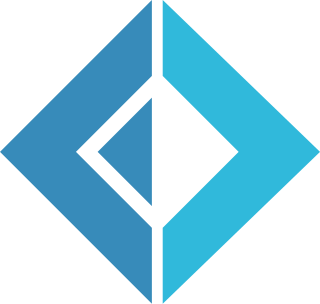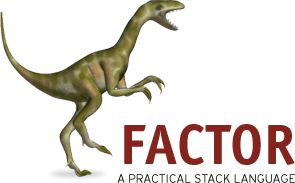
PostScript (PS) is a page description language and dynamically typed, stack-based programming language. It is most commonly used in the electronic publishing and desktop publishing realm, but as a Turing complete programming language, it can be used for many other purposes as well. PostScript was created at Adobe Systems by John Warnock, Charles Geschke, Doug Brotz, Ed Taft and Bill Paxton from 1982 to 1984. The most recent version, PostScript 3, was released in 1997.

Polish notation (PN), also known as normal Polish notation (NPN), Łukasiewicz notation, Warsaw notation, Polish prefix notation or simply prefix notation, is a mathematical notation in which operators precede their operands, in contrast to the more common infix notation, in which operators are placed between operands, as well as reverse Polish notation (RPN), in which operators follow their operands. It does not need any parentheses as long as each operator has a fixed number of operands. The description "Polish" refers to the nationality of logician Jan Łukasiewicz, who invented Polish notation in 1924.

Reverse Polish notation (RPN), also known as reverse Łukasiewicz notation, Polish postfix notation or simply postfix notation, is a mathematical notation in which operators follow their operands, in contrast to prefix or Polish notation (PN), in which operators precede their operands. The notation does not need any parentheses for as long as each operator has a fixed number of operands.

Scheme is a dialect of the Lisp family of programming languages. Scheme was created during the 1970s at the MIT Computer Science and Artificial Intelligence Laboratory and released by its developers, Guy L. Steele and Gerald Jay Sussman, via a series of memos now known as the Lambda Papers. It was the first dialect of Lisp to choose lexical scope and the first to require implementations to perform tail-call optimization, giving stronger support for functional programming and associated techniques such as recursive algorithms. It was also one of the first programming languages to support first-class continuations. It had a significant influence on the effort that led to the development of Common Lisp.

Lua is a lightweight, high-level, multi-paradigm programming language designed mainly for embedded use in applications. Lua is cross-platform software, since the interpreter of compiled bytecode is written in ANSI C, and Lua has a relatively simple C application programming interface (API) to embed it into applications.
In computer programming, the scope of a name binding is the part of a program where the name binding is valid; that is, where the name can be used to refer to the entity. In other parts of the program, the name may refer to a different entity, or to nothing at all. Scope helps prevent name collisions by allowing the same name to refer to different objects – as long as the names have separate scopes. The scope of a name binding is also known as the visibility of an entity, particularly in older or more technical literature—this is in relation to the referenced entity, not the referencing name.
In programming languages, a closure, also lexical closure or function closure, is a technique for implementing lexically scoped name binding in a language with first-class functions. Operationally, a closure is a record storing a function together with an environment. The environment is a mapping associating each free variable of the function with the value or reference to which the name was bound when the closure was created. Unlike a plain function, a closure allows the function to access those captured variables through the closure's copies of their values or references, even when the function is invoked outside their scope.
In computer science, imperative programming is a programming paradigm of software that uses statements that change a program's state. In much the same way that the imperative mood in natural languages expresses commands, an imperative program consists of commands for the computer to perform. Imperative programming focuses on describing how a program operates step by step, rather than on high-level descriptions of its expected results.

F# is a general-purpose, high-level, strongly typed, multi-paradigm programming language that encompasses functional, imperative, and object-oriented programming methods. It is most often used as a cross-platform Common Language Infrastructure (CLI) language on .NET, but can also generate JavaScript and graphics processing unit (GPU) code.

In computer science, a stack is an abstract data type that serves as a collection of elements with two main operations:

Oberon-2 is an extension of the original Oberon programming language that adds limited reflective programming (reflection) and object-oriented programming facilities, open arrays as pointer base types, read-only field export, and reintroduces the FOR loop from Modula-2.
In computer science, computer engineering and programming language implementations, a stack machine is a computer processor or a virtual machine in which the primary interaction is moving short-lived temporary values to and from a push down stack. In the case of a hardware processor, a hardware stack is used. The use of a stack significantly reduces the required number of processor registers. Stack machines extend push-down automata with additional load/store operations or multiple stacks and hence are Turing-complete.

Factor is a stack-oriented programming language created by Slava Pestov. Factor is dynamically typed and has automatic memory management, as well as powerful metaprogramming features. The language has a single implementation featuring a self-hosted optimizing compiler and an interactive development environment. The Factor distribution includes a large standard library.
Cilk, Cilk++, Cilk Plus and OpenCilk are general-purpose programming languages designed for multithreaded parallel computing. They are based on the C and C++ programming languages, which they extend with constructs to express parallel loops and the fork–join idiom.
In computer science, corecursion is a type of operation that is dual to recursion. Whereas recursion works analytically, starting on data further from a base case and breaking it down into smaller data and repeating until one reaches a base case, corecursion works synthetically, starting from a base case and building it up, iteratively producing data further removed from a base case. Put simply, corecursive algorithms use the data that they themselves produce, bit by bit, as they become available, and needed, to produce further bits of data. A similar but distinct concept is generative recursion, which may lack a definite "direction" inherent in corecursion and recursion.
Tacit programming, also called point-free style, is a programming paradigm in which function definitions do not identify the arguments on which they operate. Instead the definitions merely compose other functions, among which are combinators that manipulate the arguments. Tacit programming is of theoretical interest, because the strict use of composition results in programs that are well adapted for equational reasoning. It is also the natural style of certain programming languages, including APL and its derivatives, and concatenative languages such as Forth. The lack of argument naming gives point-free style a reputation of being unnecessarily obscure, hence the epithet "pointless style".
A property, in some object-oriented programming languages, is a special sort of class member, intermediate in functionality between a field and a method. The syntax for reading and writing of properties is like for fields, but property reads and writes are (usually) translated to 'getter' and 'setter' method calls. The field-like syntax is easier to read and write than many method calls, yet the interposition of method calls "under the hood" allows for data validation, active updating, or implementation of what may be called "read-only fields".
In computer programming, a function is a callable unit of software logic that has a well-defined interface and behavior and can be invoked multiple times.
Tcl is a high-level, general-purpose, interpreted, dynamic programming language. It was designed with the goal of being very simple but powerful. Tcl casts everything into the mold of a command, even programming constructs like variable assignment and procedure definition. Tcl supports multiple programming paradigms, including object-oriented, imperative, functional, and procedural styles.

Nim is a general-purpose, multi-paradigm, statically typed, compiled high-level system programming language, designed and developed by a team around Andreas Rumpf. Nim is designed to be "efficient, expressive, and elegant", supporting metaprogramming, functional, message passing, procedural, and object-oriented programming styles by providing several features such as compile time code generation, algebraic data types, a foreign function interface (FFI) with C, C++, Objective-C, and JavaScript, and supporting compiling to those same languages as intermediate representations.










